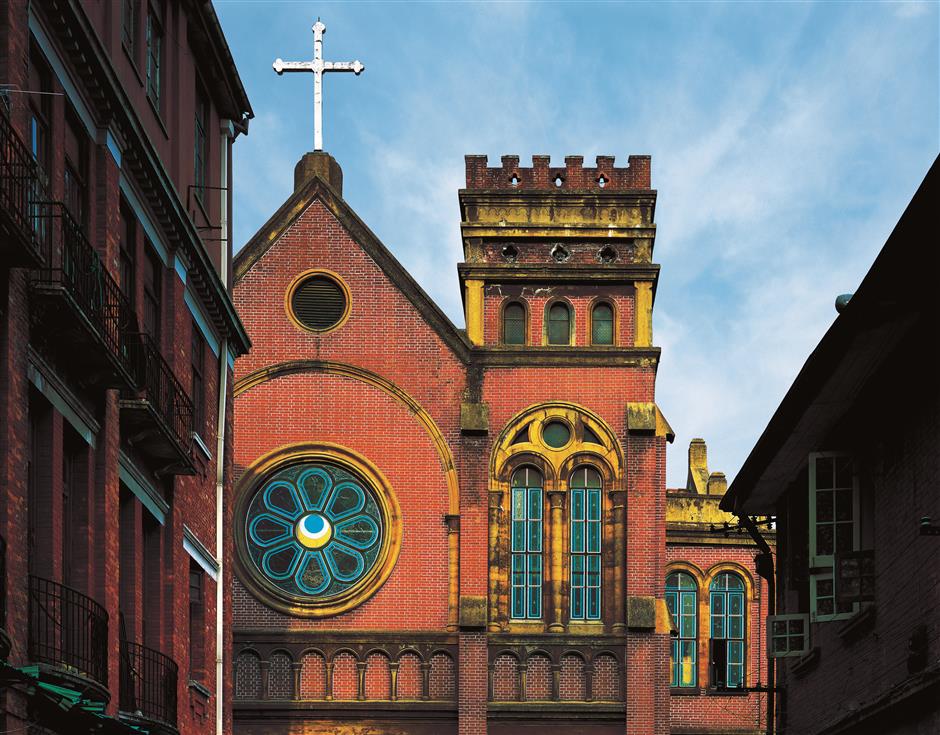Villa built to last a century marks 101 years with first open house
Jing’an is a potted history of Shanghai. Century-old villas, well-preserved traditional shikumen neighborhoods with high walls and stone gates, and renovated factories all have a story to tell. Glitzy retail malls, charming boutiques and annual music and arts events give the district a distinctive ambience and ever-growing opportunities. In this series, we explore some of the landmarks that have come to characterize the district’s culture and history.

Drummond Apartment, built in 1917, opened free to public viewing for the first time on June 9 and 10. Many other historical buildings in Jing’an also participated in celebrations marking the annual Cultural and Natural Heritage Day.
Landmark ID:
Name: Drummond Apartment
Built: 1917
Address: No.7, Lane 263, Huashan Road
Architecture: English-style villa
The historic Drummond Apartment opened free to public viewing for the first time on June 9 and 10 to celebrate the annual Cultural and Natural Heritage Day.
Tucked away in a cluster of old buildings on Huashan Road, the three-floor villa has long been off limits to visitors.
The English Renaissance-style villa was built in 1917 by Price’s (China) Ltd, a subsidiary of London-based Price’s Candles. The building later took its name from a man called Drummond, who used it as his private residence.
The red-brick facade of the main body of the villa features Corinthian columns. The dark-hued wooden staircase, decorated with beautiful carvings, and an historical fireplace with ornate carvings have been retained.
After 1949, the central government took over the building, converting it into office space. Today it serves as offices for Shanghai company Bright Food.
The district is making efforts to persuade people who now live and use historical buildings to open their doors for a weekend to allow visitors to see heritage sites.
More to explore
Jing’an has many historical sites. Some are prominent but less known to the public. Let’s have a look.

Ohel Rachel Synagogue
Ohel Rachel Synagogue
In the 1930s and 40s, about 23,000 Jews took refuge in Shanghai to escape Nazis persecution back home. The Ohel Rachel Synagogue at 500 Shaanxi Road N is a legacy of that era.
The ivy-covered synagogue is considered to be the best-preserved of the seven synagogues in Shanghai and also the largest remaining in the Far East.
It was built by tycoon Jacob Sassoon in 1920 to commemorate his dead wife. It looks like a Greek sacred hall, featuring four marble pillars and three arch gates.
It was listed on the World Monuments Watch list of endangered buildings in 2002. Now it opens its doors only to the local Jewish community for major events.

St Therese Catholic Church
St Therese Catholic Church
Of all the churches in Shanghai, St Therese Catholic Church is largely ignored because it is hidden amid rows of historical buildings on Datian Road.
The church was completed in 1931 to commemorate Saint Therese of Lisieux, a devout French nun who died at age 24 in 1897 and is widely venerated in modern times. It was said that foreign priests built the church as a place to pray to Saint Therese for the safety of the local parish in wartime.
It is a typical Gothic-style church, featuring two towers and a grand dome. Rose decorations embellishing pillars and tiles are homage to a saint popularly known as "Little Flower of Jesus" or simply "The Little Flower.”
About half a century ago, when the church was occupied by a radio factory, it suffered extensive structural damage. Renovations to the church were completed in 1993.

Former residence of DV Woo
Former residence of DV Woo
This building was the last work and yet the most avant-garde design in Shanghai by Hungarian architect Laszlo Hudec, whose icons include the Park Hotel and Grand Theater.
There are many garden villas in Shanghai, but the former residence of DV Woo, a pigment industry magnate in Old Shanghai, is different.
Regarded as one of the largest and most luxurious residences in the Far East, the building was ahead of its time, both inside and out. It’s said Hudec told Woo that the villa wouldn’t go out of fashion even after 100 years and was certain to become an architectural icon.
Completed in 1938, the four-story villa at 333 Tongren Road was built in the shape of a cruise ship.
Green-colored glazed tiles pave the façade and surrounding walls, a first in Shanghai. The décor reflected Woo’s business, which started by selling green pigments for military use. Locals called the villa “Green House.”

Former residence of the Soong family
Former residence of the Soong family
Tucked away at Shaanxi Road N. and Nanyang Road stands a fenced-off villa that once housed one of the most influential families in early 20th-century China.
The two-floor English-style villa was built in 1908 as a residence for a foreigner. Ten years later, the Soong family bought it and moved in.
The patriarch was American-educated Methodist minister Charlie Soong. He was married to Ni Kwei-tseng, a descendant of a Ming Dynasty (1368-1644) mathematician.
The couple had three daughters famed for their beauty and political prowess. The so-called “three Soong sisters” were all educated in the US and made fortuitous marriages.
The eldest Ai-ling was the wife of HH Kung, the richest man of the era in China. Ching Ling, the second daughter, married Sun Yat-sen, the forerunner of China’s revolution to end feudalism. The youngest Mei-ling married Chiang Kai-shek, later the head of the Kuomintang government.
The latter couple had three sons who were all high-ranking officials in the Kuomintang. In December 1927, the wedding ceremony of Soong Mei-ling and Chiang Kai-shek was held in the villa.
Ching Ling founded the China Welfare Institute Kindergarten at the site. It is now used by the Shanghai Soong Ching Ling Foundation.
















